Many thanks to Andy Batten-Foster for this write up.
I can’t imagine what the kite flyers made of us. We must have looked a strange bunch; a diverse group of just under thirty men, women and children marching up and down Troopers Hill in St. George (no, I’d never heard of it either) stopping every few minutes to look at something tiny on the ground. In the centre – the focus of all attention – was a tall, pony-tailed and bearded fellow in shorts, carrying a hefty stick and with a magnifying glass around his neck. It wasn’t even a very nice day.
This was the Troopers Hill annual Fungi Foray – organised by the Friends of this substantial piece of urban nature reserve – and Justin Smith couldn’t have looked more like a mushroom and toadstool expert if he’d come straight from central casting. Our little group came expecting great things – perhaps too much. Some carried books with titles like “Food for Free”, while others bore optimistically large rustic baskets they clearly hoped to fill in time for a late breakfast.
Justin (utterly charming and fired up with knowledge and enthusiasm) began by letting us down gently. There are, he told us, up to sixteen thousand species of fungi known in the UK but only a tiny proportion are edible. Also, the ones that people assume are safe because they “look alright” are often the most dangerous. During the past week he’d heard of a case in Bristol where some overly adventurous eaters had spent a night in hospital with what he called “classic mushroom poisoning symptoms” – blurred vision, vomiting and diarrhoea. They were fine next day (as most are) but it’s undoubtedly an experience worth avoiding.
Justin has seen a substantial increase in the amount of interest in fungi hunting in the last ten years. Some is certainly led by the recession and the hope of discovering free nourishment, but he’s also aware of a probably even more influential interest in natural or wild ingredients that are free of chemicals and the supermarkets’ pre-occupation with regular shapes and sizes. Whilst Justin is keen to encourage this way of thinking (he now hosts a number of Fungi Forages at different venues around the West) he’s also responsible enough to warn of the dangers. He advises those who want to eat wild mushrooms safely to get as much expert advice as possible, not to trust books or websites, and to concentrate on one or two species and get to know them incredibly well before cooking anything – or take a local course..
So, now we’d been warned not to expect a feast, the hunt began in earnest. What was truly astonishing was just how many different species of fungi we found in the two hour trek – between thirty and forty – and just how quickly everybody “got their eye in” and began discovering examples for themselves. We must have found four or five varieties at the first stop, and then another handful just yards further on. These things are everywhere! Justin held them up to the sky and then passed them around for closer examination (you have to eat them to get sick, touching them is perfectly safe) and everyone quickly became completely fascinated.
We found a Brown Roll Rim mushroom (Paxillus involutus) that Justin told us may well have been used by the Borgias to murder inconvenient relatives. It doesn’t do any harm the first few times it’s eaten, but toxins gradually build up in the body until the last taste proves fatal – but any medical examination only shows a mushroom the victim has regularly enjoyed. Crafty eh? And it looks for all the world like an ordinary chestnut mushroom nestling innocently on a supermarket shelf.
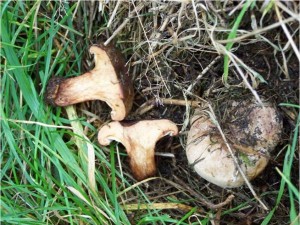
Next we discovered an extraordinary fungus that closely resembled a human ear – albeit a particularly unpleasant looking example being fleshy, slightly damp and pale pink. In less politically correct times this was known as the Jew’s or Judas’ Ear (Auricularia auricula-judae) as it was supposed to be all that remained of Judas’ body in the tree in which he hung himself. Justin assured us that, now known as Jelly Ear, this was perfectly edible and indeed rather tasty, “once you get over the slight sliminess and skin-like texture”. No one seemed keen to give it a try.
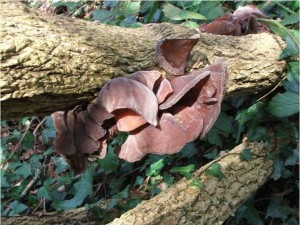
And there was one more surprise in store right at the end of our foray. No more than a tiny speck in Justin’s palm was Ergot, a highly poisonous form of fungus that grows in rye and causes wild hallucinations. Justin explained that during the Middle Ages, when most European bread was made of Rye, it’s believed that many thousands suffered horrific visions of hell as a result of unknowingly ingesting Ergot.
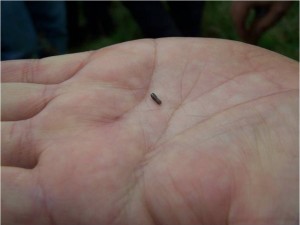
A couple of solid hours trekking up and down hills on a Sunday morning is a great way of working up an appetite – but this Troopers Hill foray couldn’t offer us breakfast (we’d not collected enough edible mushrooms to cover even one slice of toast). So if you’re planning a similar excursion – and there are lots advertised online around Bristol – make sure you have your own wild mushrooms (sensibly sourced from a reliable specialist shop) ready to cook at home.
And as far as expert mushroom recipes are concerned, Justin reckons he’s eaten around ninety species in his time and swears by the honest simplicity of frying them up in butter and garlic. Mind you, he says, a rare treat is a cauliflower fungus (sporassis crispa) that once you clean it out, coat it in flour and fry it up with parsley is absolutely delicious – if you can find one just make very, very certain it’s the real thing.
All in all then, a fascinating way to spend a Sunday and one I’d certainly recommend – and all the time the kite flyers at the top of Troopers Hill knew nothing of the discoveries we’d been making in the hedgerows way beneath them. Whatever were we up to?
Find out more about The Friends of Troopers Hill here: www.troopers-hill.org.uk
For help identifying types of common fungi follow: www.avonwildlifetrust.org.uk/wildlife/75-how_to_1.htm
Or go to the North Somerset and Bristol Fungus group at: www.nsbfg6.webspace.virginmedia.com
Justin’s own website is at: www.bristolfungi.org.uk
[mappress mapid=”86″]
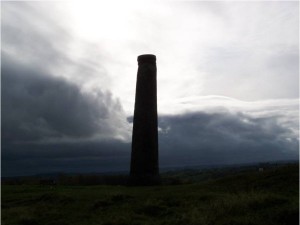
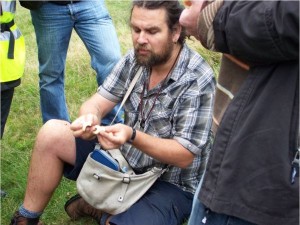
Thanks Andy, great write up.
Justin's report on the foray with the names of the 30+ species that we discoverd is now on the Friends of Troopers Hill website at http://www.troopers-hill.org.uk/Flora/FungiReport…
There was one species that has been sent to Kew for further investigation, and another that that is native in Norway but not known to be British, if confirmed this might be the first record in the UK.